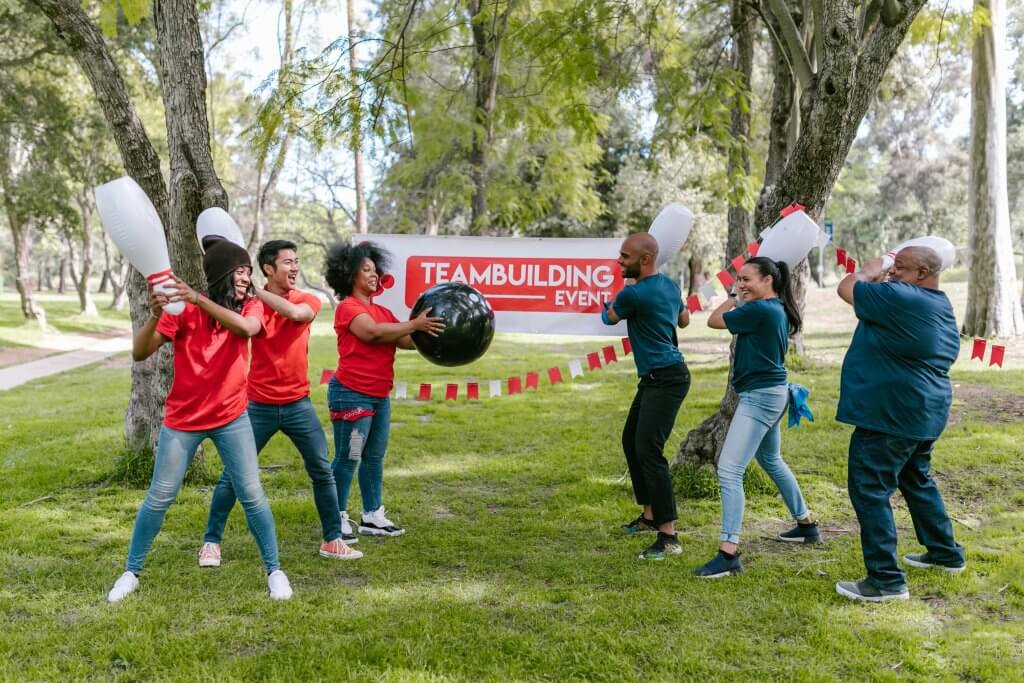Corporate wellness programs are proven to improve employee health, boost productivity and morale, and reduce healthcare costs – but not every program is created equal, and there is no one-size-fits-all approach.
However, the most successful corporate wellness programs do share common traits. At WellSteps, we call them the Program Success Standards. The closer you follow them, the more likely your program will succeed and yield desirable outcomes.
Here are five secrets to wellness program success with real-world insights from WellSteps clients who have highly successful programs.
1. Walk the Talk
Adults – much like children – engage in observational learning. When wellness program coordinators and senior management get involved, employees will follow.
For example, one company struggled with poor participation in a wellness event. We took a closer look and found that neither their coordinator nor senior leadership participated, and the event wasn’t even communicated to employees until two days prior.
For this reason, we recommended the company change their approach to lead by example. Leadership began bringing in fresh fruits and vegetables from a local farmer’s market, and their coordinator started a wellness committee to include employees in program planning.
In a short time, participation in the wellness program increased dramatically. If you want your wellness program to succeed, you must lead by example, involve your employees, and walk the talk.
John Pittman, President at Fransen Pittman Construction – which is enrolled in the WellSteps Engage program – discusses how company involvement drives wellness success.
“More than just quantitatively measuring the health of our employees, what I’m most proud of is watching the web of benefits emerge from this program that we didn’t even expect,” John says. “For example, we support the community and promote a great cause through our annual MS150 bike ride and fundraising. I’ve seen the financial strain of our employees resolve and their day-to-day attitude improve.
“Most of all, our wellness program has become embedded in our culture. Our wellness program is more than diet and fitness. It’s about how a person functions at all levels.”
Leadership Ideas
- Visibly participate in wellness campaigns
- Set your own wellness goals and share your successes
- Participate in community fun runs and share pictures
- Host walking meetings with employees
- Announce wellness program successes and elements in staff meetings
RELATED: How Leadership Can Support Wellness Program Participation
2. Communicate
Many companies fail to effectively communicate the values and benefits of their wellness programs. Additionally, they often overlook simple logistical details such as program start dates and deadlines, calendars of events, highlights, and testimonials. As a result, employees can’t participate if they don’t know what to do and when to be there, so clear communication amplifies engagement and drives measurable results.
One wellness coordinator we worked with employed two strategies to improve communication. First, she asked managers to share information about the wellness program during staff meetings. Second, she encouraged wellness committee members to discuss the program during casual conversations with their coworkers.
The result? Participation in the company’s program tripled and remained high well after she instituted those simple changes.

Stephanie Lesco, a supervisor at Lorain County Public Health, which is enrolled in the WellSteps Foundations program, illustrates the importance of communication for wellness program success.
“We keep pushing wellness. It’s not one of these things we just expect employees to do on their own,” she says. “We highlight activities in our monthly newsletter. We have people who are wellness champions from each department work directly with their team to promote wellness at staff meetings. It’s not just ‘we have this program.’ We keep it at the forefront of everyone’s minds.”
Communication has driven significant results for Lorain County Public Health, as their wellness program boasts outstanding participation rates and permeates organizational culture.
“We hear people talking about wellness campaigns and activities,” Stephanie says. “They’re talking about it in the lunchroom. I would say that’s not normal conversation if they’re not engaged in the program.”
Leadership Idea
- Send personalized invitations to managers to participate
- Offer testimonials in meetings or via email, text, or app push notifications (easy to do with the free WellSteps app)
- Promote wellness activities with posters, flyers, and postcards
- Include leadership wellness messages in newsletters
RELATED: How Senior Leaders Can Communicate Support for Wellness Programs
3. Teamwork
When wellness teams work together, they can accomplish more, increase participation, and drive desired outcomes. Without teamwork, wellness programs can collapse.
Here’s a good example: a well-intentioned wellness coordinator we know attempted to administer her company’s program on her own. They didn’t have a committee, and they didn’t communicate with their guide. Though the program launch and initial participation went well, the coordinator quickly became overwhelmed, and participation faltered.
As a result, the coordinator changed her approach. She recruited a wellness team to help plan and scheduled regular check-ins with their wellness guide. The team shared duties and began referring to it as “our program.”
The results were outstanding, as 90% of employees participated in the year’s final wellness event.
The Power of Social Influence
Teamwork extends beyond internal teams to include each employee’s social network. For example, WellSteps members can invite a spouse or partner to participate alongside them in their wellness programs. We also have team-based behavior change campaigns that boost camaraderie and engagement through friendly competition.
Social influence is a real thing when it comes to wellness, and those who have strong social support are more likely to succeed.

How Does This Work In The Real World?
Stephanie says it’s important for her team at Lorain County Public Health to meet to plan and evaluate campaigns throughout the year.
“We do a lot of planning, and our team is what really internally keeps it going,” she says. “We don’t want it to get stale, and we don’t want people to feel there isn’t value. We want to continue providing programming that is applicable to the needs of our staff, so continuing to engage them in the creation of the program is important. We would not get participation if it was created in a bubble with the wellness team.”
Stephanie adds that a team-oriented approach helps organizations cater programs to the varying needs of their employees.
“Our wellness team reps have done a really nice job of going back to departments showing they care and want feedback. Our departments are different enough that what a team in administrative service might need is different than what a team in population health might need. We have a diverse staff, so we find things that appeal to all of them,” she says.
John at Fransen Pittman Construction discusses the value of teamwork in helping employees achieve their goals.
“Our employees have quit smoking, lost weight, and increased activity levels. Additionally, the wellness program has brought a level of camaraderie to the organization through company challenges or contests,” he says. “Through group activities such as 14er mountain climbs, MS150 bike rides, and more, our employees are challenging themselves to push their physical and mental boundaries to overcome things they didn’t think that they could accomplish.”
Leadership Ideas
- Allow coordinators time and space for wellness committee meetings
- Offer incentives for wellness committee participation
- Participate in campaigns as part of the team (WellSteps has a library of team-based behavior change campaigns as well as challenges that can be done 24/7 as individuals or in peer groups)
RELATED: How to Improve Employee Morale with Wellness Programs
4. Make it Fun
The best wellness programs feature fun activities, because when wellness is fun, employees are far more likely to participate. You can do simple things to add an element of fun to your wellness program and establish a culture of wellness.

For example, one organization launched a campaign to help employees avoid holiday weight gain. The company gave employees healthy snack recipes and asked them to make the snacks and bring them in to work. Then, they shared the snacks as a group while listening to music and exchanging holiday gifts.
Another company held a walking poker activity. Employees walked to five different stations and received a playing card and health tip at each. The employee with the best poker hand won a prize.
Yet another company held “art shows” in their stairwells. Employees brought in their children’s (or their own) artwork to be displayed in the stairwells to encourage the use of the stairs over elevators.
How Does This Work In The Real World?
Courtney Foley, Human Resources Manager at Alabama Home Builders Self Insurers Fund – which participates in the WellSteps Foundations program – illustrates how making wellness fun can bolster engagement while simultaneously cutting costs.
“Popular features with our staff include large team campaigns and personal challenges. It’s fun to hear plenty of encouraging words – a.k.a. ‘smack talk’ – around the office during team campaigns,” she says. “We have had increased engagement between departments because they are connecting through wellness goals. We have also been able to keep healthcare costs increasing at a lower-than-average rate.”
Stephanie at Lorain County Public Health echoes the importance of making wellness fun: “We’re always trying to make it fun. We survey staff to get input into what campaigns we’re going to do because we know that getting buy-in from the team is important if you’re going to keep the program going.”
She says her organization mixes things up, as no two years are guided around the same subject matter, and they survey employees to discover their interests so they can better meet their needs.
“We do try to make campaigns spread across various interests. We know we can’t please everyone with everything, but we want a balance to appeal to a broader group,” she says, adding that “they don’t have to do everything. They can skip activities and do activities that appeal to them and still get enough points.”
Leadership Ideas
- Encourage fun wellness activities and allow employees to participate on the clock
- Challenge employees to “beat the top” (president/CEO/Leadership)
- Participate in pick-up games of basketball, soccer, or employee tournaments
- Offer a wide variety of activities so that employees of all abilities and interests can participate
RELATED: Fun Workplace Wellness Challenge Ideas
5. Facilitate Engagement
It’s impossible to have a successful employee wellness program without high engagement, so the most successful programs encourage participation by offering incentives tied to benefits. They then give their employees resources to succeed (such as a wellness portal designed to help employees achieve their goals).
Benefits Based Incentives
Benefits-based incentives are the most powerful tools employers have to encourage participation, and we’ve seen participation rates close to 100% with the right incentives. It’s a win-win: employees get healthier and earn incentives while employers get the benefits of a well-functioning wellness program: lower costs, greater productivity, better morale, and reduced absenteeism, among others.
Of course, it’s imperative to make incentives meaningful to employees. Examples include lower healthcare premiums, better health plan benefits, larger HSA/HRA contributions, paid days off, and retirement contributions.
Susan Adelsberger, Benefits Administrator at Be Secure – which is enrolled in the WellSteps Foundations program – says her organization’s plan is designed to reward associates with lower insurance premiums for incorporating healthy habits.
“Our associates earn rewards points that can become savings on their benefits the following year. WellSteps put that together in a neat little package for us,” she says. “We have a lot more people paying attention to their health and behaviors, making small changes that lead to bigger results. Last year, our participating associates saved over $500,000 on their health premiums.”
Stephanie says that Lorain County Public Health’s wellness rewards included money toward deductibles and HSA contributions as well as health-related prizes.
“We feel it’s important that, in addition to gift cards that WellSteps provides for campaigns, we also do extra prizes for our teams,” she says. “Something that we’ll do at the end of the year is raffle off a Garmin watch for staff who reached their goals, so we have some big prizes in addition to earning HSA dollars.”
Leadership Ideas
- Reward high participation by location or department
- Recognize department managers with high participation numbers
- Encourage competitive spirit
- Work with an insurance broker to develop an attractive wellness incentive benefits package
- Partner with a wellness program provider to incentivize your wellness program with unique rewards tailored to your employees
RELATED: Wellness Engagement Ideas to Build a Culture of Wellness
In Closing…
The most successful corporate wellness programs incorporate the five standards listed here, but it’s key to remember there is no one-size-fits-all approach to wellness. It’s crucial to design a custom program that resonates with your employee base to achieve measurable, lasting results.
WellSteps can help. We have extensive experience designing fun, engaging, and successful wellness programs that foster employee wellbeing across the six pillars of wellness and deliver value for organizations. Schedule a demo to learn more today.
